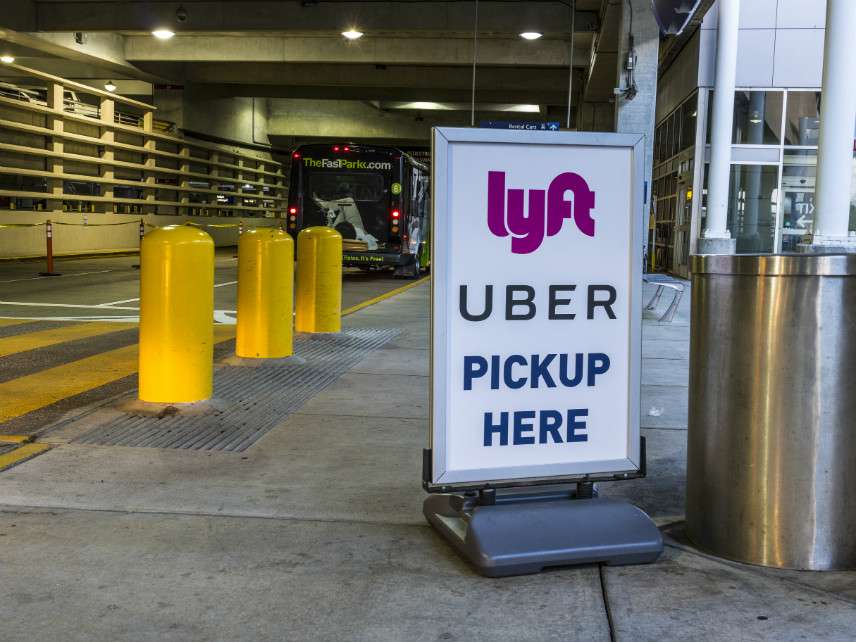No, the Sharing Economy Isn't Dead
How to understand new data on independent contracting.

For years, we've heard about the growth of the sharing economy as online platforms like Uber continue to shape the U.S. economy. But how influential are they really?
A recent Bureau of Labor Statistics survey on alternative work arrangements claims that there are fewer independent contractors today than there were in 2005—back before Uber's founding. Considering that the ubiquitous online platforms rely on independent contractors, this survey led some to declare the death of the sharing economy.
But don't start writing the obituary for the side hustle yet. This new data doesn't prove that the gig economy is dead.
It's important to realize just what the government was measuring. It turns out that the government's survey design paints an incomplete picture of the labor market by excluding millions of entrepreneurial independent contractors. Yesterday, I testified before a House Education and the Workforce subcommittee to set the record straight.
BLS created the Contingent Worker Supplement (CWS) in 1995 to measure work outside of the standard, more common employer-employee relationship. This month's update followed a 13-year gap in releasing the survey. While the CWS contains lots of interesting data, its finding that only 6.9 percent of workers are independent contractor received the most attention, and rightfully so. This measure is down from 7.4 percent in 2005 and less than half the level of most other estimates.
The CWS's main flaw is that it only tracks alternative work if these jobs are a primary source of income. This decision creates problems for the measurement of independent contractors. An office worker who drove with Lyft after work on the weekends would count as an independent contractor unless his Lyft earnings exceeded those from his day job. In other words, all side hustlesare excluded from the government's measures of alternative work.
Other government statistics tell a different story. Data from the Federal Reserve's Enterprising and Informal Work Activity survey estimates that 36 percent of workers took part in all types of freelance work in 2015—five times the level found by the CWS. Of these freelancers, 56 percent are formally employed in other jobs. Similarly, in its survey of around 8,000 U.S. and EU independent workers, the McKinsey Global Institute finds that 56 percent of respondents use independent work to earn supplemental income.
But the problems extend beyond excluding supplemental independent contractor work. The CWS only considers work done in the previous week. Given the nature of freelance work, it would be better to ask about independent contractor jobs over the previous year. A construction worker may freelance as a math tutor through Thumbtack over the slower winter, or a college student may do TaskRabbit deliveries during summer breaks. And since independent contractors are their own bosses, people working side hustles have countless reasons to simply choose to not put in the extra hours during certain weeks.
Another factor that lowers the CWS's measures of overall independent work compared to other estimates is the decision to exclude self-employed people who are not independent contractors (such as shop or restaurant owners).
While there is potential for confusion from some respondents if they owned an Etsy shop, for example, this decision makes sense given that this group of self-employed people is captured under BLS's monthly employment survey. As the CWS's technical note states, "Nearly 9 in 10 independent contractors are self-employed. Conversely, 3 in every 5 self-employed workers are independent contractors."
Additionally, survey respondents may not realize their worker classification status. For people who identify themselves as wage and salary workers, the CWS asks if last week they were working as "someone who obtains customers on their own to provide a product or service." Uber drivers could be forgiven for thinking that they did not obtain customers on their own because they relied on the application as an intermediary.
Despite leaving out millions of workers who use independent contractor gigs for supplemental income, the CWS did provide evidence to counter the notion that all independent contractors are helpless workers stuck in low-wage, insecure jobs that they hate.
The CWS's independent contractors as quite secure in their jobs, as only three percent are classified as contingent workers. Contingent means that workers do not expect their jobs to last or that they work temporary jobs. This is the same percentage as workers in traditional employment arrangements.
When it comes to take-home pay, the CWS finds that median weekly earnings for full-time independent contractors are $851, which is right in line with pay for workers in traditional arrangements ($884). Furthermore, educational attainment among independent contractors is in line with workers in traditional work arrangements, providing evidence that people of all education and skill levels can find ways to work independently. Far from only encompassing low-paying "gig" jobs, the most common industry in which independent contractors work is in the high-paying field of professional and business services.
While the CWS is a very accurate survey, its design leads to an incomplete picture of independent work. Two simple updates to the survey (and a commitment to releasing it more than once every 13 years) would go a long way towards providing some much-needed data on the changing workforce.
First, the CWS needs to measure alternative work that provides supplemental income. Second, it should use a one-year lookback period instead of only asking about work completed during the previous week.
Until those results are available, there is no reason to mourn the death of the sharing economy.




Show Comments (26)